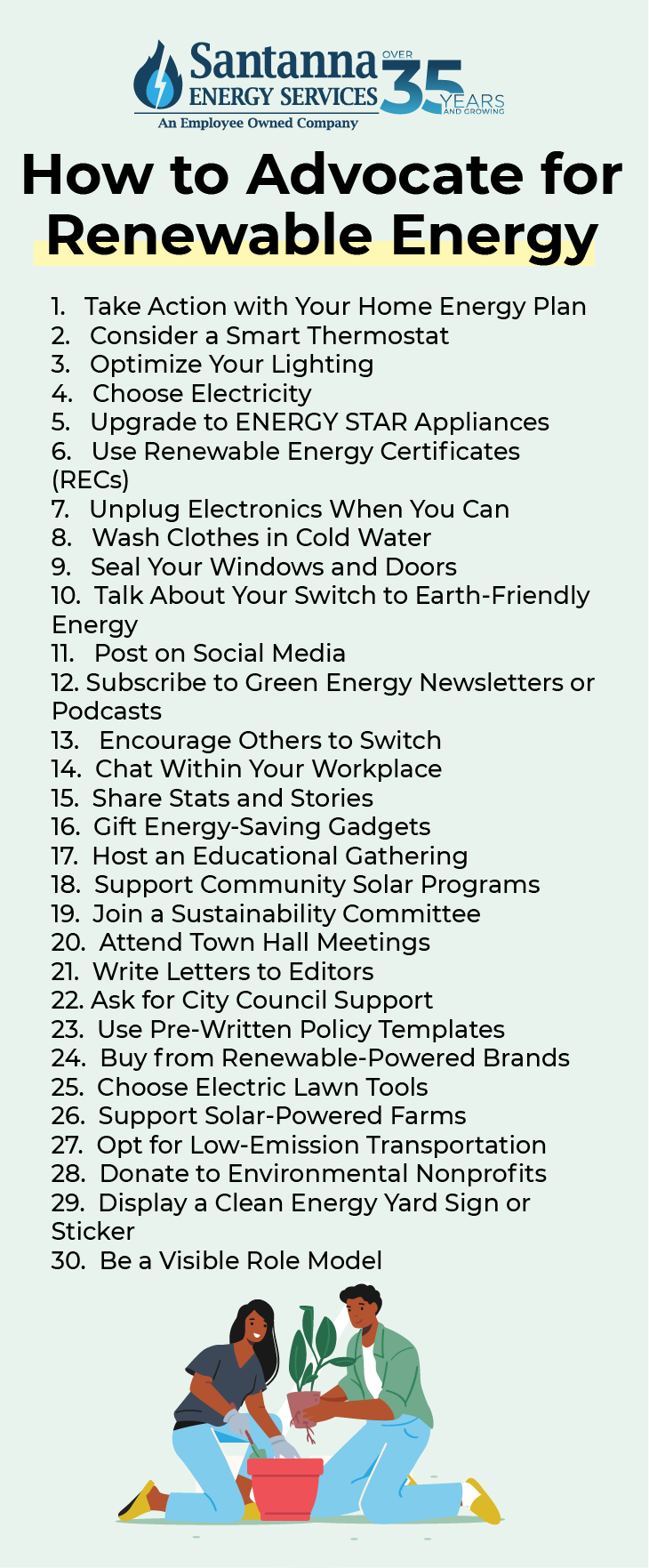How to Advocate for Renewable Energy in Your Daily Life (Even Without Solar Panels)
by Jenna Mendez
17.2 min read

If you care about sustainability, you're not alone. Many of our customers, and likely you, too, are eco-conscious homeowners or renters who want to do their part for the planet. According to recent national surveys by CleanPower.org, over 80% of Americans support expanding renewable energy.
However, when it comes to advocating for renewable energy, it's easy to feel like the only real options are installing solar panels or attending public hearings. That's not the case.
Some of the most impactful steps you can take happen in your everyday life. Whether you're just beginning your journey or ready to take your impact a step further, we've got you covered with practical, meaningful actions that don't require installing a single panel. Keep reading and explore how to advocate for renewable energy in a way that works for your lifestyle.
Key Points of This Article:
- Supporting renewable energy is possible through everyday choices—from your electricity plan to the conversations you have with friends.
- Unlike fossil fuels, renewable sources like wind and solar can be used again and again without depleting the planet.
- Smart thermostats, LED bulbs, and unplugging unused electronics can cut emissions and save money, starting today.

How to Advocate for Renewable Energy
Advocacy doesn't have to mean rallies or policy debates. It starts right where you are, at home, in your conversations, and in the choices you make every day. Here are some of the best ways to advocate for renewable energy:
1. Take Action With Your Home Energy Plan
Start advocating for renewable energy with how you power your home. Consider enrolling in an earth-friendly electricity plan to show your support for renewable energy and spread the word while you do it!
If you're not sure where to start, take a look at our Earth-Friendly Plans, which support clean energy sources such as wind and solar with no rooftop panels or installation required.
If you're looking for a gas option to keep things carbon neutral, our Earth-Friendly Natural Gas plan is just right for you and the planet!
2. Consider a Smart Thermostat
Using a smart thermostat can help reduce energy demand and save approximately 8% annually on heating and cooling costs, while easing pressure on the power grid during peak hours.
Smart thermostats are superstars in programming! They allow you to set your thermostat temperature when you're in and out of the house, so you can always have your home set at an earth-friendly temperature.
3. Optimize Your Lighting
Switch to energy-efficient LED lighting to lower your electric bills and reduce energy use, especially when demand is high. LED light bulbs are much cheaper and more efficient than traditional incandescent bulbs.
To further advocate for renewable energy, take this tip a step further by gifting a loved one with a pack of bulbs so they can optimize their home and spread the green goodness!
4. Choose Electricity
Electricity is much more efficient than natural gas. Electrify your home appliances by replacing gas-powered stoves and water heaters with cleaner, more efficient electric options.
5. Upgrade to ENERGY STAR Appliances
ENERGY STAR-rated appliances use significantly less energy and water than standard models, helping you save on utility bills while reducing your carbon footprint. Choosing certified products means you're meeting high energy efficiency standards without sacrificing performance.
6. Use Renewable Energy Certificates (RECs)
RECs allow you to match your home's electricity use with renewable sources, even if you don't have direct access to wind or solar power. Purchasing RECs supports the development of green energy projects and helps drive clean energy forward.
7. Unplug Electronics When You Can
Even when they're turned off, electronics can still draw power if they're plugged in. Unplug idle electronics or use smart power strips to reduce phantom energy load, and you could save up to $100 per year on unnecessary standby power.
8. Wash Clothes in Cold Water
Heating water accounts for most of the energy used in laundry. Switching to cold water cycles and air drying when possible significantly reduces energy use without compromising cleaning power.
9. Seal Your Windows and Doors
Sealing your windows and doors to improve insulation in your home is one of the best things you can do to keep your home green and efficient. According to EnergyStar.gov, drafts in your home can contribute to 25% to 40% of the energy used for heating and cooling, leading to significant energy loss.
10. Talk About Your Switch to Earth-Friendly Energy
Sharing your earth-friendly energy choices with friends and family makes renewable energy feel more accessible and trustworthy. Personal stories can be a powerful spark for others to make the switch.
11. Post on Social Media
Social platforms can amplify your advocacy if you're truly passionate about renewable energy and dedicated to advocating for it. In our experience, our customers appreciate hearing about advancements in renewable energy and learning about personal stories.
Doing so helps you spread awareness and normalize sustainability in your community and beyond.
12. Subscribe to Green Energy Newsletters or Podcasts
Staying informed about renewable energy helps you become a more effective advocate. Subscribing to sustainability-focused newsletters or podcasts keeps you up to date on innovations, policies, and ways to take action, and makes it easier to share accurate information with others.
13. Encourage Others to Switch
Happy with your renewable energy plan? Encourage others to join in on the goodness! When people hear how easy and impactful the switch is, they're more likely to take that step themselves.
14. Chat Within Your Workplace
If appropriate, bring conversations about clean energy into your workplace. We've seen in our organization that small conversations can lead to bigger green initiatives! Whether it's proposing energy audits or discussing green electricity options, your voice can lead to change.
15. Share Stats and Stories
Love the numbers? We do, too! It's no secret that data builds credibility and stories build connections. When you combine both, you help others understand the value of renewable energy on both a personal and global level.
16. Gift Energy-Saving Gadgets
Take an eco-friendly approach to gift-giving. Practical gifts, such as LED bulbs or smart plugs, help others adopt more sustainable habits. Just think, that smart gift you give a friend might encourage them to adapt to more eco-friendly tech.
17. Host an Educational Gathering
Bringing people together to watch a documentary or hear from a local expert can raise awareness and inspire action. Small events can have a big ripple effect in your community!
18. Support Community Solar Programs
Community solar helps those who can't install panels at home gain access to renewable energy. Participating or advocating for these programs helps increase clean energy equity.
19. Join a Sustainability Committee
Getting involved in a local climate or sustainability group gives you a seat at the table. You can help guide your community's decisions toward a cleaner, greener future.
20. Attend Town Hall Meetings
We've found that public forums are opportunities to show support for renewable energy projects. By attending and speaking up, you help counter misinformation and promote clean power solutions.
21. Write Letters to Editors
Consider your local newspaper as an outlet! Publishing a letter in your local paper helps inform your community and spark discussion. It's a simple, public way to advocate for clean energy initiatives and policies.
22. Ask for City Council Support
City councils play a key role in local energy decisions. Advocating for clean energy resolutions ensures that public buildings and services lead the way in sustainability
23. Use Pre-Written Policy Templates
Looking to write a letter to advocate for renewable energy? Use templates from trusted organizations like the DOE or EPA to contact lawmakers. It's an easy way to support equitable and effective energy policy.
24. Buy from Renewable-Powered Brands
Some companies run entirely on renewable energy or offer high-end renewable energy products. Supporting these businesses helps grow the clean energy market and encourages more companies to follow their lead.
25. Choose Electric Lawn Tools
Electric mowers, trimmers, and blowers produce far less pollution than gas-powered versions. Making the switch helps reduce air pollution in your neighborhood and beyond.
26. Support Solar-Powered Farms
Farmers and co-ops using solar help bring clean energy into agriculture. Supporting them helps expand sustainable practices and strengthens local, eco-conscious food systems.
27. Opt for Low-Emission Transportation
Switching to electric vehicles, biking, or using public transportation helps reduce greenhouse gas emissions, especially since transportation is a leading contributor in the U.S.
28. Donate to Environmental Nonprofits
Organizations focused on renewable energy access, education, and policy require funding to sustain their work. Supporting nonprofits with a donation—big or small—helps amplify the renewable energy movement.
29. Display a Clean Energy Yard Sign or Sticker
Simple visuals, like a yard sign, bumper sticker, or window decal, can show your support for renewable energy and invite curiosity and conversation from neighbors and passersby.
30. Be a Visible Role Model
Every day, choices matter. When you consistently choose clean energy and sustainable habits, you inspire others to do the same, sometimes without even realizing it.
What Is the Difference Between Nonrenewable and Renewable Energy?
To put it simply, nonrenewable energy comes from sources that will eventually run out. These include coal, oil, natural gas, and uranium (used for nuclear energy). They're called nonrenewable because they take millions of years to form and can't be replaced on a human timescale. Once we use them up, they're gone.
Most nonrenewable sources, like coal, oil, and natural gas, are known as fossil fuels. They were created deep underground from the remains of ancient plants and animals, compressed over millions of years by heat and pressure.
That's why they're called "fossil" fuels. These resources are pulled from the earth in different forms: solid (coal), liquid (crude oil), and gas (natural gas).
In contrast, renewable energy, like solar, wind, and hydropower, comes from natural sources that can quickly replenish themselves. The sun keeps shining, the wind keeps blowing, and rivers keep flowing, which makes these sources much more sustainable in the long run.
So what's the big takeaway? Renewable energy can be used again and again. Nonrenewable energy can't. And once we burn it, the damage it leaves behind (carbon emissions, pollution, and resource depletion) is hard to undo. That's why making the switch to cleaner, more sustainable sources matters.
Which States Produce the Most Renewable Energy?
When it comes to clean energy leadership, some states are pulling ahead faster than others. Let's take a look at how much power each U.S. state generates from renewable sources. By comparing both total output and percentage of electricity from renewables, you'll get a clear picture of where your state stands and where there's room to grow.
How Much Renewable Power Each U.S Generates
| State | Renewable in Gigawatt-hours |
| Alabama | 56450 |
| Alaska | 2105 |
| Arkansas | 19420 |
| California | 107066 |
| Colorado | 21004 |
| Connecticut | 18040 |
| Delaware | 142 |
| District of Columbia | 87 |
| Georgia | 49979 |
| Hawaii | 1911 |
| Idaho | 12812 |
| Illinois | 124055 |
| Iowa | 46433 |
| Kentucky | 4743 |
| Louisiana | 19505 |
| Maryland | 18139 |
| Massachusetts | 287 |
| Michigan | 39887 |
| Mississippi | 10393 |
| Montana | 14397 |
| Nebraska | 19616 |
| Nevada | 15145 |
| New Hampshire | 3293 |
| New Jersey | 30653 |
| New Mexico | 16655 |
| North Carolina | 61649 |
| North Dakota | 18784 |
| Oklahoma | 40240 |
| Oregon | 44110 |
| Rhode Island | 868 |
| South Carolina | 61093 |
| South Dakota | 15835 |
| Texas | 180145 |
| Utah | 5643 |
| Vermont | 2038 |
| Washington | 101000 |
| Wisconsin | 16356 |
| Wyoming | 11075 |
Renewable Energy Production in Pennsylvania
Let's talk about where Pennsylvania stands when it comes to renewable energy, and why it matters for you.
Right now, Pennsylvania generates just 6,658 thousand megawatt-hours (MWh) from renewable sources. That's only 2.7% of its total electricity generation, which puts Pennsylvania near the bottom of the list nationwide.
In fact, according to PennEnvironment, Pennsylvania ranks 49th in the country for growth in clean energy over the past decade, particularly in solar, wind, and geothermal energy.
So what does that mean for everyday homeowners and renters? Simply put, it's harder to find affordable, renewable electricity plans here compared to other states.
Fewer clean energy programs and limited utility options make it tough to access the savings and benefits that solar and wind can offer in places with more aggressive renewable policies.
Renewable Energy Production in Illinois
Illinois is making significant strides in clean energy. The state generates nearly 28,879 thousand megawatt-hours (MWh) from renewable sources, which accounts for approximately 15.3% of its total electricity.
That's a solid step forward, and a lot of that progress is thanks to the expansion of wind farms in rural areas across the state.
So, what does this mean if you live in Illinois? It means you've got more options.
Homeowners and renters alike have growing access to community solar programs and meaningful statewide initiatives like Illinois Solar for All. This program is designed to make solar energy more affordable for income-qualified households, opening the door for more people to take part in the clean energy shift and reduce their energy bills in the process.
Renewable Energy Production in Ohio
Ohio is starting to tap into its clean energy potential, generating around 8,096 thousand megawatt-hours (MWh) of electricity from renewable sources. That makes up about 5.6% of the state's total power, and while it's not the highest, it's a meaningful foundation to build on.
Most of Ohio's renewable energy comes from wind, which accounts for 53% of the state's renewable generation, especially in the northwest, and utility-scale capacity is growing.
This means local homeowners—particularly in wind-rich regions—can benefit from emerging clean energy programs and more affordable green electricity options, even without rooftop solar.
Renewable Energy Production in Michigan
Michigan is making steady progress toward a cleaner energy future. The state currently produces around 14,399 thousand megawatt-hours (MWh) from renewable sources, about 11.3% of its total electricity. That mix includes wind, solar, and hydro, and it's only expected to grow.
Under the MI Healthy Climate Plan, Michigan has committed to some ambitious but achievable goals: reaching 52% renewable energy by 2030, and 100% carbon neutral by 2050. That's big news—not just for the environment, but for homeowners, too.
What does that mean for you if you live in Michigan? It means more clean energy options are becoming available close to home. With community solar programs, Renewable Energy Certificates (RECs), and other initiatives expanding, you don't need to install rooftop panels to participate.
What Are the Advantages and Disadvantages of Renewable Energy?
Renewable energy offers many exciting benefits—from cleaner air to lower electric bills—but it's not without its challenges. Let's break down the advantages and disadvantages of renewable energy to help you understand how these factors impact your home, your wallet, and the planet.
Advantages of Renewable Energy
- Sustainable and Always Available
Renewable sources like sun, wind, and water naturally replenish and won't run out—unlike fossil fuels, which are finite resources. - Significantly Lower Carbon Emissions
Generating electricity without burning fossil fuels substantially reduces greenhouse gas emissions, helping to slow climate change. - Improves Air and Water Quality
Because clean energy avoids combustion, it reduces pollutants that harm respiratory and cardiovascular health and decreases water contamination. - Creates Local Jobs and Boosts Regional Economies
The Midwest has added over 25,000 clean energy jobs, with nearly three-quarters of a million workers now employed in the sector. - Reduces Reliance on Imported Fuels
Producing clean energy locally reduces dependence on foreign oil and gas, which improves energy security and shields homeowners from price spikes. - Low Maintenance and Operating Costs
Technologies like solar panels and wind turbines have fewer moving parts than traditional power plants, meaning lower upkeep and operating costs over time. - More Stable Energy Prices
Renewables rely on free natural resources (sun, wind), making them less vulnerable to volatility in fuel markets or geopolitical tensions. - Can Increase Property Value
Homes associated with green energy or community solar subscriptions often see increased appeal and resale value due to energy cost savings. - Supports Broader Environmental Goals
By cutting carbon emissions and resource use, renewable energy supports wildlife protection, ecosystem preservation, and overall sustainability. - Cleaner Energy Independence
Being powered by renewables helps communities gain energy independence and provides more resilient and decentralized electricity systems.
Disadvantages of Renewable Energy
- Weather-Dependent Generation (Intermittency)
Solar and wind generation fluctuate depending on weather conditions—cloudy days reduce solar output, and calm days limit wind energy production—making them less consistent than other energy sources. - High Upfront Infrastructure Costs
Building wind farms, solar installations, or upgrading grids requires substantial investment, though long-term savings often offset initial expenses. - Energy Storage Is Still Evolving
Because renewable output is inconsistent, storing excess energy (e.g. in batteries or pumped hydro) is essential, but large-scale storage remains expensive or limited. - Location Constraints
Not all areas are suitable for every type of renewable energy—communities in cloudy, low-wind, or non-geothermal regions may face limited options. - Large Land and Resource Use
Utility-scale solar and wind projects require extensive acreage, which can raise concerns about land use, habitat disruption, or visual impact. - Manufacturing and Disposal Footprint
Producing and disposing of solar panels, batteries, and turbines involves significant resource use and emissions, making recycling and end-of-life management critical. - Moderate Energy Output per Footprint
Renewable installations generally produce lower energy density than fossil fuel plants, requiring more installations to meet demand. - Labor and Supply Challenges Slowing Growth
Rapid expansion in solar and storage is creating labor shortages, raising project costs and slowing deployment in some areas. - Grid Modernization Needs
Many regional power systems were originally designed for centralized energy generation, so adapting the grid to support distributed renewable sources like rooftop solar or wind farms often requires costly infrastructure upgrades. - Not Entirely Carbon-Free
Although clean during operation, manufacturing and transport of renewables produce some emissions, though these are significantly lower than fossil fuels.
FAQs
What is a Renewable Energy Certificate (REC)?
A Renewable Energy Certificate (REC) reflects the environmental benefits of 1 megawatt-hour (MWh) of electricity generated from a renewable source and delivered to the power grid. It allows consumers to claim that amount of clean energy usage, even if the physical electrons they receive come from mixed sources. Buying RECs helps support renewable generation and track progress toward cleaner energy goals.
Is electrical energy renewable?
Electricity itself isn't inherently renewable; it depends on how it's produced. If it's generated from wind, solar, hydro, or geothermal sources, it's renewable. If it comes from coal, gas, or nuclear, it isn't. Even on mixed power grids, pairing your usage with RECs or enrolling in green electricity plans can make your electricity effectively renewable.
Can I support clean energy if I rent?
Absolutely. Renters can benefit from clean energy through community solar programs, portable solar solutions, or by choosing green electricity plans. Community solar allows subscribers (whether homeowners or renters) to receive renewable energy credits on their bills without installing panels. It's a practical and inclusive way to participate in clean energy growth.
Is renewable electricity more expensive?
In many areas, choosing renewable electricity may cost a few cents more per kilowatt-hour, but it also offers long-term value. Unlike fossil fuels, renewables stabilize energy prices over time by avoiding market volatility. According to analysts, as more renewables are built, wholesale prices fall, creating more stable bills for consumers.
What happens if I can't install solar?
If rooftop solar isn't an option for you, there are still impactful ways to support clean energy. You can enroll in a green electricity plan, use Renewable Energy Credits (RECs) to match your usage with clean power, or join a community solar program. These alternatives let you reduce your carbon footprint and contribute to renewable energy growth—no panels required.
Supporting renewable energy isn't just for homeowners with rooftop solar or big budgets. As you've seen, advocacy can take many shapes. Even small steps, like switching to LED bulbs or encouraging a friend to go green, can create a ripple effect that moves us all toward a more sustainable future.
At Santanna, we're proud to be the energy supplier of choice for thousands of customers across the American Midwest. And we've made it easy to support renewable energy, no panels, no installations, no upfront cost. With our Earth-Friendly plans, we match 100% of your electricity usage with Renewable Energy Credits (RECs), so your energy is backed by clean sources like wind and solar. Plus, for every new enrollment, we'll donate to plant trees.* This simple gesture has a lasting impact.
So whether you're just getting started on your clean energy journey or ready to take it to the next level, now's the perfect time. Explore Santanna's Earth-Friendly plans and start making a difference—right from home.
* Santanna Energy Services (Santanna) works in partnership with One Tree Planted. For every residential Earth-Friendly Santanna gas or electricity initial enrollment or renewal, Santanna, via its One Tree Planted partnership, will plant trees after 60 days of billed usage. Plans may vary. See plan details for eligibility and current tree-planting promotions.
Jenna Mendez is a Midwest native with lifelong roots in Illinois and time spent in Ohio during college, giving her a deep understanding of the Midwest region’s people, climate, and energy needs. She brings firsthand experience and local insight to topics that matter to Midwest homeowners, especially energy efficiency, sustainability, and home living. Jenna specializes in writing about eco-friendly living, all things Midwest, renewable energy, and practical ways to reduce energy costs. Jenna brings a trusted, and local hometown voice to every article she writes, helping readers live well, and sustainably, right where they are.







